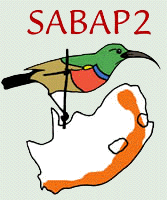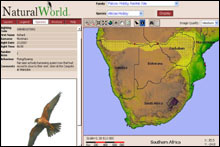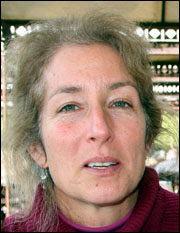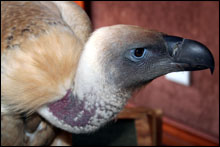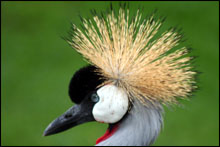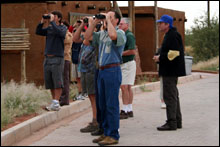SAEON to assist in keeping an eagle eye on Southern Africa's birds
|
New Bird Atlas project maps the distribution and abundance of birds in
South Africa, Lesotho and Swaziland
The second Southern African Bird Atlas Project (SABAP2) was officially launched on 26 June at the Pretoria National Botanical Garden.
The project is a joint venture between the Avian Demography Unit of the University of Cape Town, BirdLife South Africa and the South African National Biodiversity Institute. The three organisations are collaborating to produce an updated benchmark bird atlas for the region, and to provide an opportunity to see how bird distributions have changed since SABAP1, for which the fieldwork was completed 15 years ago. Their work will add to our understanding of the distribution and abundance of bird species across the sub-continent.
During the past 15 years bird distribution patterns in southern Africa have changed, possibly more rapidly than during the previous 30-40 years. Large-scale landscape changes, resulting in widespread habitat loss, transformation and fragmentation, and in some cases habitat creation, coupled with climate change and invasion have contributed to changing bird distributions. Unusual sightings have for instance been recorded all over Gauteng in recent times, such as the six white-faced owls that were spotted in the greater Johannesburg area.
Avian Demography Unit (ADU) director and project leader for SABAP2, Prof Les Underhill, stresses the importance of monitoring change in bird distributions. "Birds can be used as indicators of landscape and/or climate change," he explains. "Like miners of old used a canary as an early warning sign of hazardous conditions ahead, we are using birds to warn us of what lies ahead of us in terms of climate and the environment."
"Birds tend to respond very rapidly to habitat changes and environmental changes through time," says James Harrison of the University of Cape Town. "Through studying birds and their distribution we derive warnings and pointers about what is happening in the world." The data provide scientists with insights into how our environment is changing, changes that place huge pressure on birds. And it is birds that can be "pulse monitored", that show how and where that change is manifesting.
Monitoring these changes in distribution is crucial if we are to put in place proper and effective management plans to conserve bird populations and diversity in southern Africa into the future, especially as the change in landscapes and climate patterns is expected to continue.
Based on recommendations from both the scientific and birding community, SABAP2 was identified as the project to lead the way in monitoring these ecological changes. The project organizers are enlisting the assistance of farmers, landowners, nature reserves, birders, natural scientists and "citizen scientists", who played an immensely valuable role in SABAP1.
This is also where SAEON comes into the picture. The various SAEON nodes will serve as focal points to monitor bird distribution and abundance in the region's savanna, forest, fynbos, wetlands, coastal, marine and arid areas.
"Rome is burning," Dr Phoebe Barnard, ornithologist at the South African National Biodiversity Institute (SANBI), and head of the Birds and Environmental Change Partnership said at the launch.
"We live in a time of unprecedented environmental change. Those of us who are a bit older are starting to see changes which are alarming - in the country, in the region, in the continent and in the world as a whole. I think we all have an obligation in these times to make sure that our information is usable, and is used by the people who have the power to change the way things are done."
Crucial snapshots of the environment
Conducting projects such as the bird atlas at regular intervals is of great value in measuring the effects of global climate change on birds. SABAP2 serves as the forerunner to SABAP3 in about 2017. Each of the projects (SABAP1, SABAP2, SABAP3, and so on) provides snapshots of how birds react to changes in the environment. It will gather updated, finer-scale distribution data through professional and public participation, providing a "second snapshot" of bird distribution in South Africa, Swaziland and Lesotho.
With its publication in 1997, the landmark Southern African Bird Atlas Project (SABAP1) created the biggest biodiversity database in Africa. SABAP2 hopes to do much the same. The project has been designed to build on the successes of SABAP1 and make an even greater contribution to biodiversity planning and conservation in southern Africa.
The first Southern African Bird Atlas Project
The first Southern African Bird Atlas Project was described as the largest biodiversity project ever conducted on the continent of Africa. It triggered unprecedented efforts to understand and preserve our continent's remarkable wealth of bird species. Large amounts of information about the distribution of birds were collected.
The project culminated in the publication of the first bird atlas in
1997, which consisted of two volumes on the distribution and relative
abundance of southern African birds. It mapped the distribution of
birds right across the African subcontinent and further afield.
SABAP1 largely achieved its objective of providing the first
quantitative description of the distribution of all bird species in
southern Africa, and represented a "snapshot" of the distribution of
each species during the late 1980s to early 1990s.
It was also the first project of its kind in southern Africa to involve so many "citizen scientists". It made a huge contribution to the public understanding of science, participation in biodiversity data collection and public awareness of birds.
This public interest and involvement was sustained after SABAP1 by the launch of focused projects such as the Coordinated Waterbird Counts (CWAC), Birds In Reserves Project (BIRP) and Coordinated Avi-faunal Roadcounts (CAR), which showcased the birding public's commitment to making further contributions to bird conservation in South Africa.
Frog, reptile and butterfly atlases follow
The success of SABAP1 was also reflected in the fact that the software developed for SABAP1 was used to develop atlas projects for other faunal groups. The Southern African Frog Atlas Project (1996-2003) piggy-backed and modified the technology developed for SABAP1 to produce the first comprehensive account of the distribution and status of all 115 known frog species in South Africa, Lesotho and Swaziland.
The atlasing concept was then transferred to reptiles and currently the Southern African Reptile Conservation Assessment (SARCA) is collecting information on the distribution and diversity of reptiles in South Africa, Lesotho and Swaziland. SARCA started in 2005 and plans to finish in 2009.
The Southern African Butterfly Conservation Assessment (SABCA) was launched in May 2007 and avid butterfly watchers and photographers can now contribute to a project that aims to determine the distribution and conservation priorities of butterflies in southern Africa.
The second Southern African Bird Atlas Project
SABAP2 has two broad aims. The first is to establish a scientifically rigorous, repeatable platform for tracking the impacts of environmental change on southern African birds through time and space.
To serve the first aim, information gathered from SABAP2 will need to be in a format comparable with the information available from SABAP1 to monitor exactly how the situation has changed. But to improve the scientific rigour of SABAP, and take advantage of improved technology and analytical tools, SABAP2's methodology will be considerably refined. Where SABAP1 provided the baseline, SABAP2 will build and advance on that baseline. The project will generate better and improved data which will ultimately assist in more efficient conservation planning.
The major changes to SABAP2 from SABAP1 include:
- a finer spatial scale (pentad grids and not quarter-degree grids);
- a tighter temporal resolution (maximum five days' observation period and not a calendar month);
- increased standardization of data collection (everyone will record species in the same way); and
- a measure of observer effort (recording of species will be linked to time spent in the field).
SABAP2 still involves recording the presence or absence of species within a grid cell, but will vastly improve coverage in grid cells and ensure better quality of data overall.
Public participation is crucial
The second aim of this project is increased public participation in biodiversity data collection through large-scale mobilization of citizen scientists, and increasing public awareness of birds.
"The SABAP2 message will be relayed to as many people as possible and training of participants will be an important component in this process," says Neil Smith of BirdLife South Africa, the project's Publicity, Outreach and Training Coordinator for SABAP2. "It will be important to roll out the project to as many participants as possible, including those people that are not members of bird clubs or BirdLife South Africa."
According to Dr Phoebe Barnard, the findings of SABAP2 will be vital in synergising the information collected for Biodiversity Planning and Conservation at the national level. She also promised birders at the launch that SABAP2 was going to be "even better, more fun and more useful" than SABAP1.
Citizen scientists - this is YOUR project
Avian Demography Unit director and project leader for SABAP2, Prof Les Underhill says: "We are going to need enormous amounts of participants to cover the nearly 18 000 grid cells into which we have divided the country this time."
It is therefore necessary to enlist the support of citizen scientists to participate in SABAP2. The information gathered by citizen scientists is vital in assisting conservationists to make the right decisions in the face of the serious consequences of environmental change.
"Citizen scientists" will play an important role - the bird clubs, amateur ornithologists and landowners who are the project's eyes and ears. It is estimated that they will record species distribution across more than 2 000 grid cells.
Any person interested in natural history, and with bird identification and map reading skills can participate in SABAP2.
Prof Underhill has the following message for would-be participants: "By participating in SABAP2, you will get to know your area, get to know your birds and raise your birding skills. Go out there and start atlasing. You will not only make friends, but you will be making history as well."
Prospective atlasers should register online at http://sabap2.org as soon as possible, as the start of data collection is imminent.
For further information contact Neil Smith, Conservation Division Manager (BirdLife South Africa) on 082-859-3788 or conservation@birdlife.org.za
OR
Doug Harebottle, Project Manager SABAP2 (Avian Demography Unit, UCT) on 021-650-2330 or doug.harebottle@uct.ac.za.


